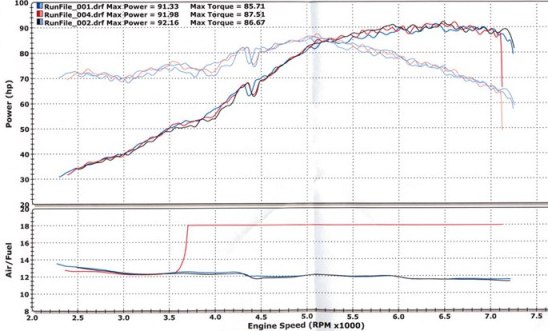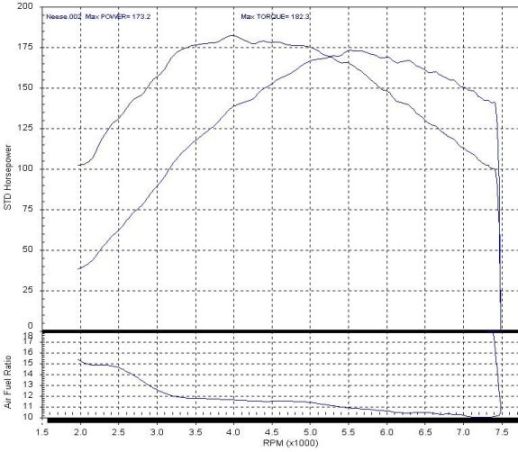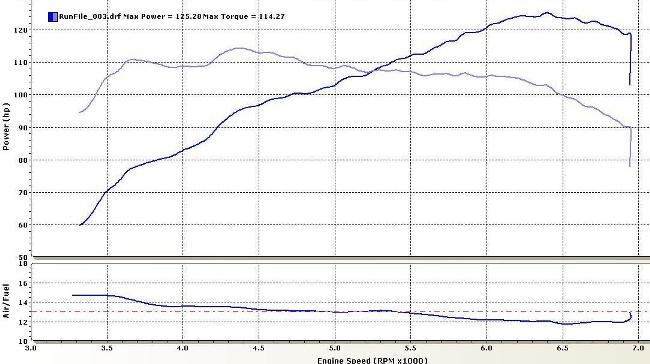Engine Models
Each generation MR2 was available with a number of engine models. The cars are often refered to by this code.
The dynamometer graphs below are representative curves from stock cars measured with a corrected Dynojet. The cars were not new when dyno’d so your results may vary to +/- 10% or more. Units are in wheel horsepower and torque.
MKI
- 3A-LU: Normally aspirated, available only on the base-model AW10 in overseas markets. Only one is known to have reached American shores.
- 4A-GE: 1.6 liter, 16 Valve, DOHC, 112 hp at 6600 rpm, compression ratio 9.4:1, 97ft lbs @4800. All 4A-GEs and 4A-GZEs sold before 1990 (including all MR2s) are known as “bigports” due to the large intake ports, which were reduced in size in 1990 (“smallport,” see end of page).

- 4A-GZE: 1.6 liter, 16 valve, DOHC, supercharged, 145hp at 6400rpm, compression ratio 8.0:1, 140 ft lbs at 4000 rpm torque.
MKII
- 3S-FE: 2.0 liter, 16 valve, DOHC, 120 hp at 5200 rpm (available only in Japanese and U.K. markets)
- 3S-GE: 156-200 hp depending on version (available in Europe & Japan)
- 3S-GE (Gen. 2): 156-160 hp at 6600 rpm, compression ratio 10:1
- 3S-GE (3): 173-177 hp at 7000 rpm, compression ratio 10.3:1
- 3S-GE (4): 197 hp at 7400 rpm , compression ratio 10.5:1
- 5S-FE: 2.2 liter, 16 valve, DOHC. 130 hp from 1990-92, 135 hp 1993+, 145 lb-ft all years, compression ratio 9.5:1 (available in USA)
- 3S-GTE: 2.0 liter, 16 valve, DOHC, turbo, fuel injection, 200-245 hp at 13psi boost.
- 3S-GTE (USA, Gen. 2 only): 200 hp at 6000 rpm, 200 lb-ft at 3000 rpm, compression ratio 8.8:1

- 3S-GTE(Gen. 2 Japan): 225 hp at 6000 rpm, 1991-1993 compression ratio 8.8:1
- 3S-GTE(Gen. 3 Japan): VVT-i; 245 hp at 6000 rpm, compression ratio 8.5:1, 1994+
MKIII
- 1ZZ-FE: 1.8 liter, 16 valve, DOHC, VVT-i system, 138 hp at 6400 rpm and 126 lb-ft of torque at 4200 rpm, compression ratio 10:1

Reading the Engine Code
The first number is the revision number of the block; the following letter designates the engine family (block design).
- For example: 3S- = 3rd version of S block.
The second part of the code describes everything above the head gasket.
- G = Performance Head, twin cam, at least a 45 angle between intake and exhaust valves. “G” may also just mean Yamaha-produced as all “G” heads have been designed by Yamaha.
- F = Economy Head/Toyota designed, narrower angle between valves
- T = turbocharged
- Z = Supercharged
- E = Electronic fuel injection
- L = Lean combustion (transversely mounted)
- U = Passes the Japanese emission regulations
- C = Passes the California emmissions regulations; emissions package or carburated (depending on year/model)
- B = twin carbs
Example:
- 4A-LC = 4th revision of the “A” engine block, lean combustion, carburetted.
- 22R-EC = 22nd revision of the “R” block with EFI and emissions (CA?) package.
Other engines that are commonly installed into MR2s (Swap Guide for the MR2 Newbie)
- 4A-GE Smallport: sold in USDM 1990/91MY Corolla GT-S and 1990-92MY Geo Prism GSi. Though they are very rare, at 130hp they are a good smog-legal upgrade from the normally aspirated bigport 4A-GE and are also very easy to swap into the Mk I. A-series motors (4A-GE, 4A-GZE, 7A-FE, or 20v 4A-GE) are only practical to swap into the Mk I chassis. See /MKI/LargePortAndSmallPort for a detailed comparison of the bigport and smallport motors.
- 4A-GZE Smallport: 1990+ version of the supercharged motor sold in AW11s, though only sold in FWD Corollas overseas. 165 or 170PS rating due to MAP load sensing, distributorless ignition, 10psi pulley, revised manifold/head, 8.9:1 compression. Very strong and easy to drive powerband.
- 4A-GE 20-valve: A 20-valve version of the 4A-GE sold in 1992-1998 FWD Corollas overseas. 155/165PS rating. 8200rpm redline, individual throttles, 10.5 or 11:1 compression. Lightweight and simple, but needs to be kept high in the RPM range to make power. A 6-speed transmission is rare and hard to adapt to RWD use, but available. Gas mileage is also outstanding. See MR220V’s 20V swap FAQ, 20vMKI.com, 20V Enthusiast Blog, and EricS’s blacktop swap.
- 7A-FE: This is the 1.8l version of the 4A-FE that was sold in the Corolla platform starting in 1993. It was rated at 115hp and 115lb-ft, which is very similar to the stock 4A-GE’s rating, but combined with the wide-valve-angle 4A-GE head it commonly produces 130-160hp depending on other modifications (and termed 7A-GE). AW11 owners commonly use this block as a basis for high-power engine builds because it’s almost exactly the same as the 4A block, but with 200cc more displacement. Supercharged or 20-valve 7A combinations are not uncommon. See Aaron Willis’s 7A-GE website.
- 3S-GTE: Installed in a Mk I chassis, the “Mk 1.5” swap has become popular in the past 5-10 years. Any model 3S-GTE with E153 transaxle can be installed using weld-in motor mounts available from Speed Source. It’s also relatively easy to retrofit a Mk II normally aspirated car with a turbo motor. No running 3S-GTE-powered MR2 Spyder street cars are known.
- 3S-GTE Gen 3+: The 3rd generation 3S-GTE motor got a revised turbo, intake manifold, and cylinder head, along with more boost, lower compression, and MAP load sensing, and was considered underrated at 245PS. It was only sold overseas but provides reasonably power gains over a 2nd generation motor. See MR2.com’s article for a complete list of differences between 2nd and 3rd gen. motors. 4th and 5th generation motors make slightly more power than 3rd gen. motors, but are much rarer, more expensive, and harder to integrate with stock electronics.
- 5S-FE: A few people have installed 5S-FEs into their Mk I MR2 (earning the nickname “Mk 1.22 or 1.25”). Though it adds a bit of weight over the stock 4A-GE, its strong torque band is considered a good match for the Mk I chassis. The 5S-FE’s well-known reputation for high reliability, fuel economy, and parts availability combined with a mild power increase and very little parts cost can make this a good “halfway step” towards a Mk 1.5, since the transmission and engine mounts can be reused with a 3S-GTE.
- 3S-GE Gen 3/4: Overseas normally aspirated 3S-GEs made significantly more power than the USDM 5S-FE. The “BEAMS” motors (4th and 5th generations 3S-GE) had ITBs, modified head geometry, made up to 207hp and fit easily into a Mk II chassis and relatively easily into the Mk I. High compression and multiple-geometry intake manifolds lead to good gas mileage. Also noteworthy that the OEM transmission on all 3S-GE motors is the same as that of the normally aspirated 5S-FE USDM cars.
- 1MZ-FE/3MZ-FE: All-alloy V6 sold in the Camry platform. 1MZ-FE (3l) was rated at 168 to 210hp depending on the year, while 3MZ-FE (3.3l) was rated at up to 225hp. Easy to swap into a Mk II chassis due to compatibility with the stock transaxle, though it is no more difficult to put in a Mk I chassis than a 3S-GTE. About the same weight and peak power as a 3S-GTE, but gets better mileage and has no turbo lag. Supercharged examples are not uncommon, for example Brad Bedell’s USCC-winning 1MZ-powered 1991 MR2.
- 3VZ-FE/5VZ-FE: Iron-block 3.0l (3VZ) or 3.4l (5VZ) used primarily in small trucks and SUVs, though could be found in Camry platform cars as well. The 3VZ-FE was rated at 185 to 200hp and the 5VZ-FE was rated at 190hp, but with significantly more torque. These engines are very heavy but also very strong. They will bolt to an E153 or S54 transaxle for installation into an MR2. See Levi’s installation page at /MKII/JDM3vz-feEngineSwap or Paul Wood’s 3VZ-FE MR2 conversion.
- 2GR-FE/1GR-FE: This is Toyota’s newest V6. The 2GR (3.5l) is rated at 268-270hp and is found in Camry platform cars (Camry, Rav4, Highlander, Avalon). The 1GR (4.0l) makes 236-239hp with much more torque and is found in the Tacoma, FJ Cruiser, etc. This swap is just starting to gain popularity as the modern electronics are hard to adapt and even harder to modify. MR2OC member Gouky has a running 2GR-FE-powered MR2 and sells an installation kit at this link. Several 2GR-powered MR2 Spyders are running in the US and UK as well. The 2GR-FSE, which is the direct + port-injected version found in the Lexus IS350, makes 306hp but it is not known at this time whether it will fit into an MR2. To run on Toyota electronics requires a throttle-by-wire conversion, returnless fuel system, and certain ECUs require the inclusion of the immobilizer and corresponding key.
- 2ZZ-GE: This motor from the Celica GT-S (also Lotus Elise/Exige) fits directly into an MR2 Spyder. The mechanical and electrical portions of the swap are relatively very easy. This motor is rated at 164-190hp and revs to 8200rpm. It has a second cam profile similar to Honda’s VTEC that provides a jump in power above a certain RPM. It also has continuously variable cam phasing and was the first motor to offer both types of VVT together. It weighs only about 25lbs more than the Spyder’s 1ZZ, gets great gas mileage, and can be installed fairly easily with the Celica/Lotus 6-speed transmission. At least one has been successfully installed in a Mk I MR2 (see blown59’s swap documentation), however none have yet been installed in the Mk II.
- Others: Oddball swaps have included Audi’s 4.2l longitudinal V8, Bill Strong’s notorious Northstar V8 swap (not finished), Mazda’s direct-injected turbo 2.3l, multiple Chevy pushrod V6s, and several electric motor conversions.
Those interested in installing a non-original motor into their MR2 should search through the appropriate engine swap forum at either www.mr2oc.com or www.mr2.com where you can find documentation of experiences others have had with any of the above projects. The difficulty of an engine swap can vary from little more than removing and replacing a motor to cutting and reinforcing the unibody, rewiring the entire car and dash, etc., and owners are strongly recommended to do their research before they start.
Federal and CARB legality of swaps:
CARB states allow engine swaps as long as the new motor was either sold in the same chassis, or if the motor was sold in the US and meets CARB standards. Thus, an AW11 owner can swap from a 4A-GE to a USDM 4A-GZE, but not to a JDM 4A-GZE (same motor except the lack of EGR) or a 20-valve 4A-GE (never sold in US). Or, a Mk II owner could swap a 1MZ-FE into their car if all of the smog equipment was in place. To be smogged, the ECU must throw no codes, all smog equipment must be present and functional, the catalytic converters must be in place, and the car must pass a sniffer test.
All MR2s are not old enough to be exempt from federal or CARB emissions standards.